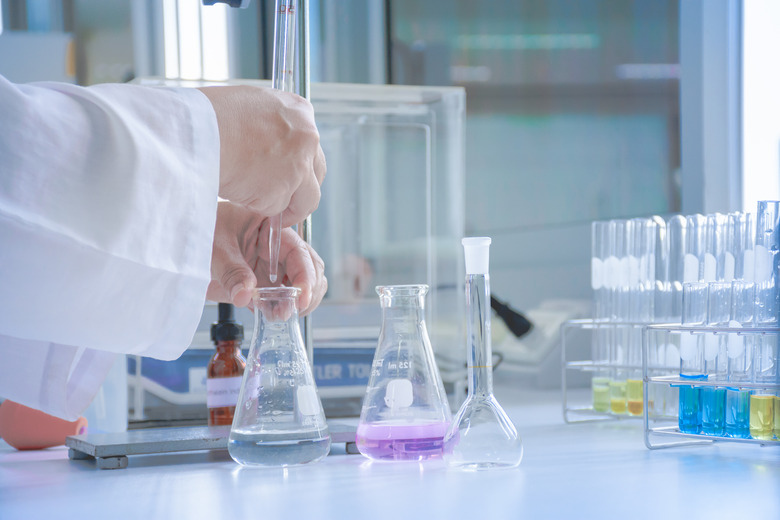How To Calculate The Number Of Moles In A Solution
A mole calculation in a solution requires using the molarity formula. The volume of the solution and the solution concentration is needed.
Molarity Definition and Formula
Molarity Definition and Formula
Molarity is the number of moles of solute per liter of solution. A solute, which can be solid, liquid or gas, is a substance that is dissolved in a solvent. The solvent is another substance that is capable of dissolving it within its intermolecular spaces. Together, the dissolved solute and the solvent make a solution.
Molarity is also considered molar concentration because it is the measure of a concentration of a solution. The formula for molarity may be expressed as:
**M ****=** mol / L
- M is molarity
- Mol is the moles of the solute
- L is the liters of solution
Moles: Chemistry and Counting Atoms and Molecules
Moles: Chemistry and Counting Atoms and Molecules
To fully understand molarity, the mole concept must be understood. A mole (often abbreviated to mol) is a unit of measurement. It is a certain amount. If a dozen bagels were purchased, the amount, if counted, would be 12 bagels.
A mole, like the word dozen, denotes a particular amount, too. However, the amount, called Avogadro's number, is very large: 6.022 × 1023.
If a mole of bagels were purchased, they would nearly fill the interior space of the Earth. Although a mole of anything can be counted, it is usually reserved for incredibly small items, like atoms and molecules.
Mole Concept in Solutions
Mole Concept in Solutions
One mole of any element or chemical compound is always the same number. One mole of hydrogen would mean there are 6.022 × 1023 atoms of hydrogen.
A mole of sodium chloride, NaCl, is the same amount, 6.022 × 1023. Here, however, it is 6.022 ×1023 molecules. With molarity, consider the moles of solute as finding the number of molecules in solution.
Calculate Moles in Solution
Calculate Moles
in Solution
The values for concentration and liters of solution must be given or calculated.
Example problem: Sugar, or sucrose, easily dissolves in water. How many moles of sucrose are in a 0.02 M solution?
Step 1: Locate Molarity and Liters of Solution
Step 1: Locate
Molarity and Liters of Solution
In the problem, the molar concentration, M, is given: 0.02 M. The volume is assumed to be 1 L since the definition of molarity is moles of solute per liter of solution.
Step 2: Use Molarity Formula
Step 2: Use Molarity Formula
Use the formula from "Molarity Definitions and Formula" (above) to solve for moles:
M = mol / L
Rearranging to solve for moles of solute:
**mol ****=** M **×** L
mol = 0.02 mol/L × 1 L = **0.02 mol of sucrose,** **C12H22O11**
There are 0.02 moles of sucrose in a 0.02 M sucrose solution.
Using Number of Moles to Find Grams
Using Number
of Moles to Find Grams
Commonly, a question asks for grams of solute, especially if the substance must be measured in a laboratory setting. If the question asks for how many grams of sucrose must be added to make a 0.02 M solution, these additional steps may be followed:
Step 3: Find Molar Mass
Step 3: Find
Molar Mass
While the counted amount of a mole of any substance is 6.022 x 1023, the molar mass of that substance will be different. For example, sodium chloride, NaCl, will have a different mass than table sugar, sucrose, C12H22O11.
Every element has a different molar mass, commonly located under the symbol on a periodic table. For example, one mole of carbon (C) has a mass of 12.01 g/mol. The molar mass of hydrogen (H) is 1.01 g/mol, and oxygen (O) is 16.00 g/mol.
For example, the molar mass of sucrose would be calculated by adding the molar masses of the individual elements:
- Sucrose contains 12 carbon
atoms: 12 × 12.01 g/mol = 144.12 g/mol
- Sucrose contains 22 hydrogen
atoms: 22 × 1.01 = 22. 22g/mol
- Sucrose contains 11 oxygen atoms: 11 × 16.00 = 176 g/mol
Add all the individual components of sucrose together:
144.12 g/mol + 22.22 g/mol + 176 g/mol = 342.34 g/mol
The molar mass of sucrose, **C12H22O11, is 342.34 g/mol**
Step 4: Find Grams of Solute
Step 4: Find Grams
of Solute
Use the number of moles calculated in Step 2 and the molar mass of sucrose from Step 3 to solve for grams:
0.02 mol of C12H22O11 × 342.34 g C12H22O11 / 1 mol C12H22O11 = 6.85 g C12H22O11
6.85 grams of sucrose dissolved in water will make a 0.01 M solution.
Cite This Article
MLA
Kozlowski, Rosann. "How To Calculate The Number Of Moles In A Solution" sciencing.com, https://www.sciencing.com/calculate-number-moles-solution-2740/. 1 March 2020.
APA
Kozlowski, Rosann. (2020, March 1). How To Calculate The Number Of Moles In A Solution. sciencing.com. Retrieved from https://www.sciencing.com/calculate-number-moles-solution-2740/
Chicago
Kozlowski, Rosann. How To Calculate The Number Of Moles In A Solution last modified March 24, 2022. https://www.sciencing.com/calculate-number-moles-solution-2740/
